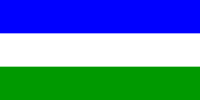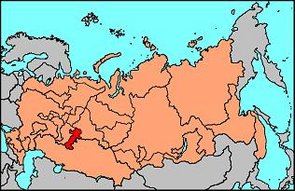Republic of Chelyabinsk

| |
| Subdivision of: | Russian Federation |
| Cities: | |
| Capital: | Tankograd (1,078,000) |
| Other: | Kokovsk (416,000) |
| Language: | Russian |
| President: | Valentin Sergeyevich Kokov |
| Prime minister: | Valentin Sergeyevich Kokov |
| Area: | ??? |
| Population: | ca. 3.9 million inhabitants |
| Established: | 1991, after the fall of the SNOR |
 Location of the Republic of Chelyabinsk in the Russian Federation | |
The Republic of Chelyabinsk is one of the smaller republics, that constitute the Russian Federation. It is located just east of the Ural mountains. It borders with the Ural Republic in the North, the Republic of Qazaqstan in the South, and the Republic of Başqortostan in the West.
The city of Chelyabinsk was founded in 1736, but its growth started only in the 19th century, when it was connected with the rest of Russia by a railroad. Nowadays, Chelyabinsk is one of major industrial centers of Russia. Heavy industry predominates. Apart from that, the region is rich in natural resources like iron ore and zinc.
During the Second Great War, Vissarionov decided to move a lot of Russian factory production to places out of the way of the advancing German armies — Chelyabinsk was one of the factory cities that was built pretty much from scratch at this time. Several enormous facilities for the production of T-34 tanks and Katyusha rocket launchers existed in Chelyabinsk, and it gained the town nickname "Tankograd" (Tank City). As a rewards for its services, this became the city's official name in 1952. A return to the previous name was contemplated after the fall of the SNOR, but never came into effect. Therefore, the republic is nowadays known as "Chelyabinsk", but the city still as "Tankograd".
In 1991, Chelyabinsk was one of the first republics that declared independence during the events that led to the dissolution of the Russian Empire. But where most regions did so in order to achieve freedom and independence, in the case of Chelyabinsk it was the opposite. It was the domain of a snorist potentate, Valentin Kokov, who saw the end of the SNOR coming and fought for independence of his city-state in order to prevent that from happening on his own territory. Thus, Chelyabinsk became a snorist bulwark in an otherwise more or less democratic Russia. It was the first republic where the SNOR was legalised again, and the only republic where it is allowed to use its former name: SNORČ.
Kokov still rules his republic, of which he is the undisputed leader, with iron first. He is both president of the republic, chairman of the government, and leader of the SNORČ. Around Kokov, a tall, bald-headed man who often dresses up in a uniform with a long, leather coat, a lively personality cult has developed. His portraits and statues are everywhere in the republic, and the second city of the republic, Magnitogorsk, was renamed "Kokovsk" in 1995.
The republic of Chelyabinsk is sometimes half-jokingly referred to as "Kokovistan".
| |||
|---|---|---|---|
| Republics | |||
|
Adygeya | Altai | Bashkortostan | Buryatia | Chuvashia | Don Republic | Kalmykia | Khakassia | Komi Republic | Mari-El | Mordovia | Muscovy | Nenetsia | North Caucasian Federation | Perm Republic | Primorye | Qazaqstan | Republic of Chelyabinsk | Republic of Petrograd and Novgorod | Republic of the Volga Germans | Tannu-Tuva | Tatarstan | Tocharstan | Udmurtia | Union of Mansiland and Khantiland | United States of Siberia | Ural Republic | Vozgian Republic | Yakutia |